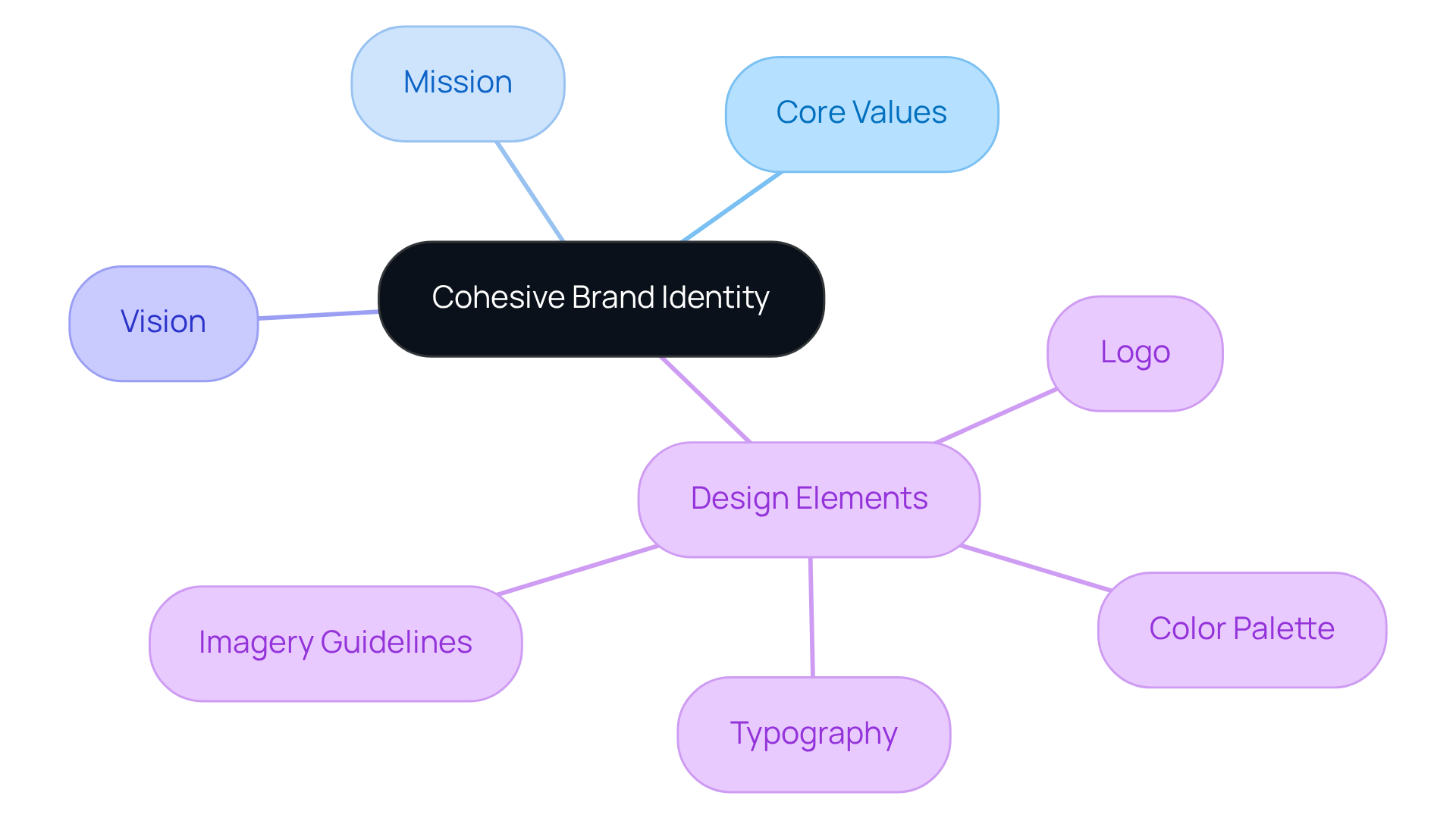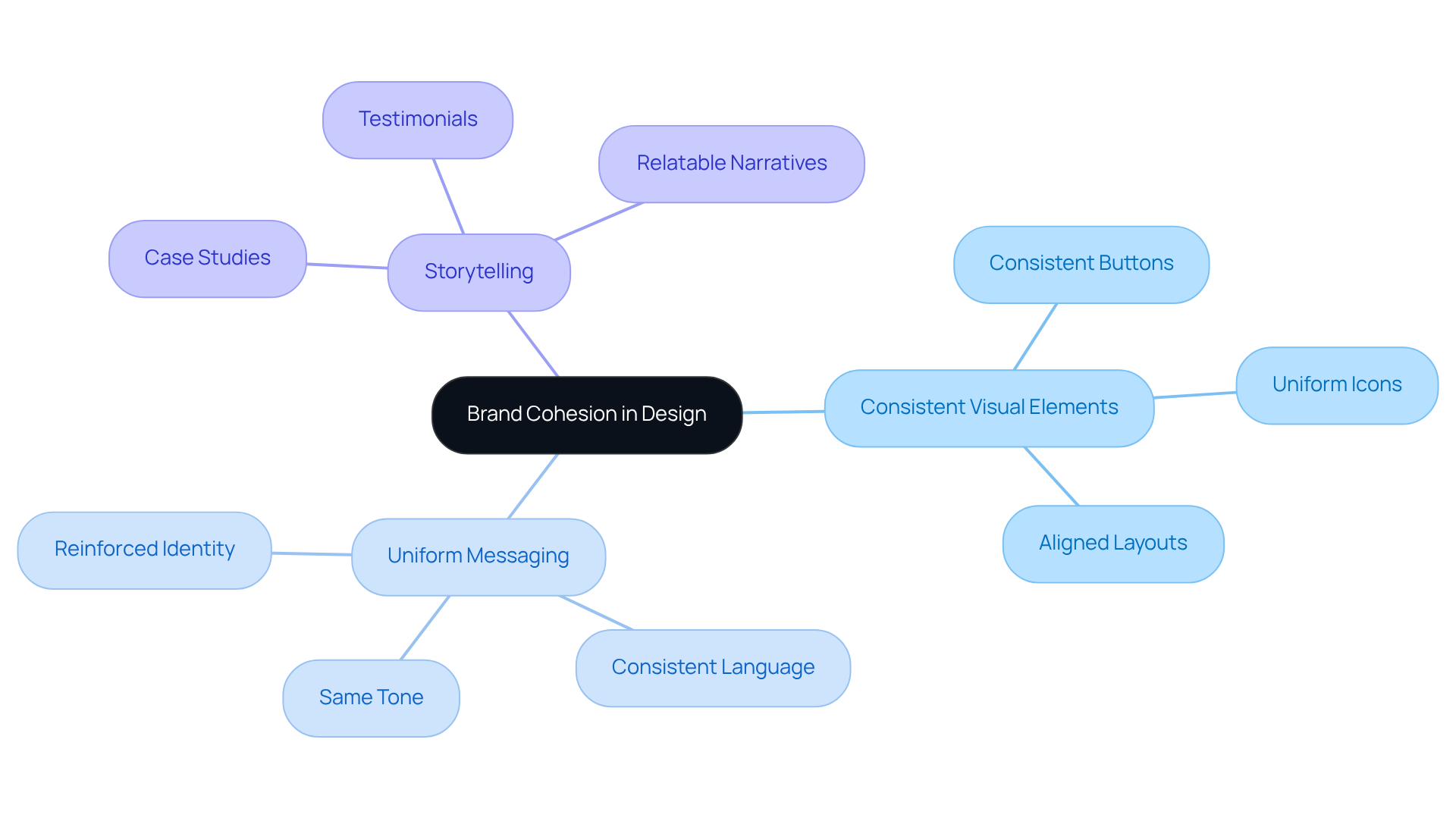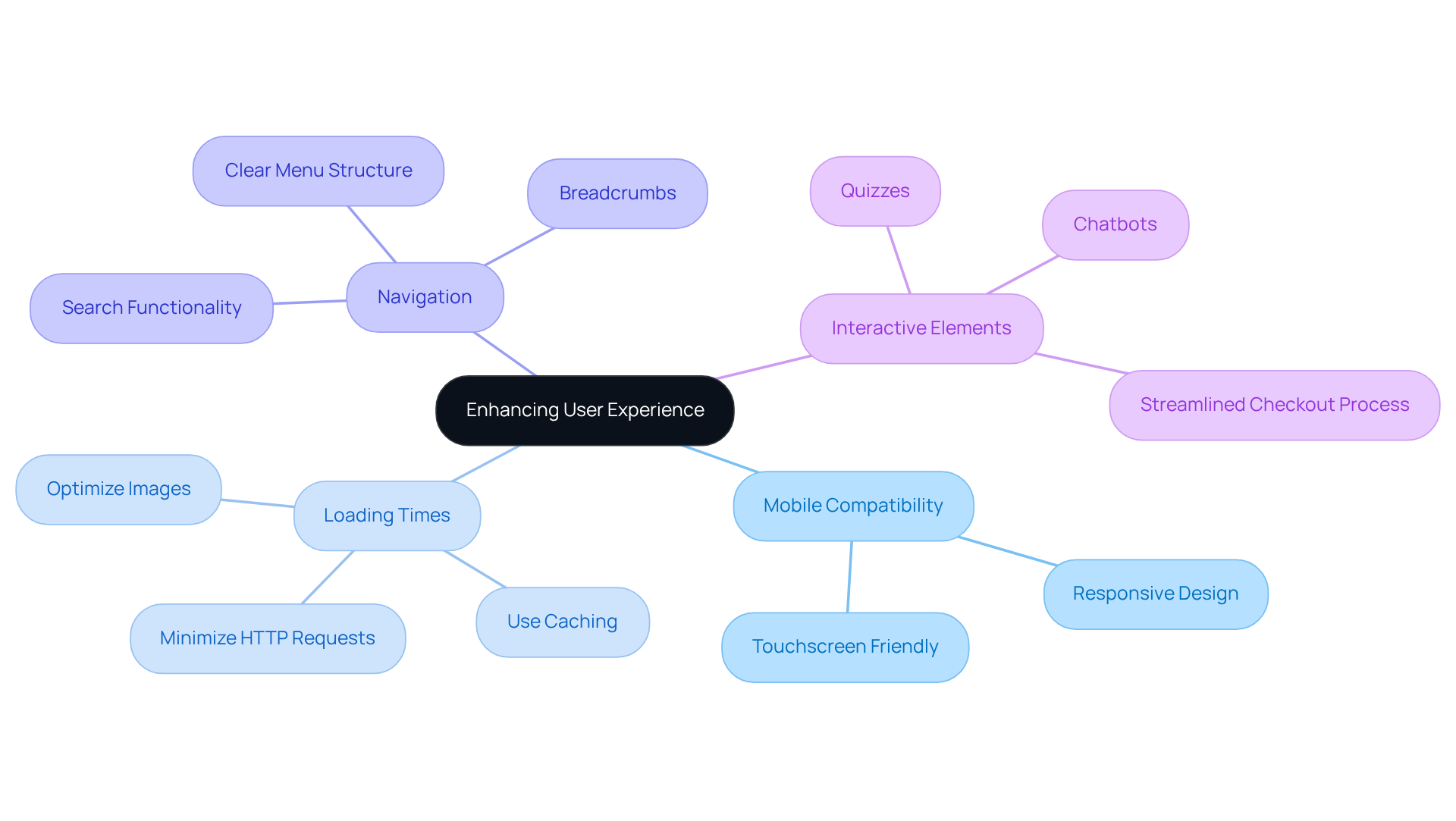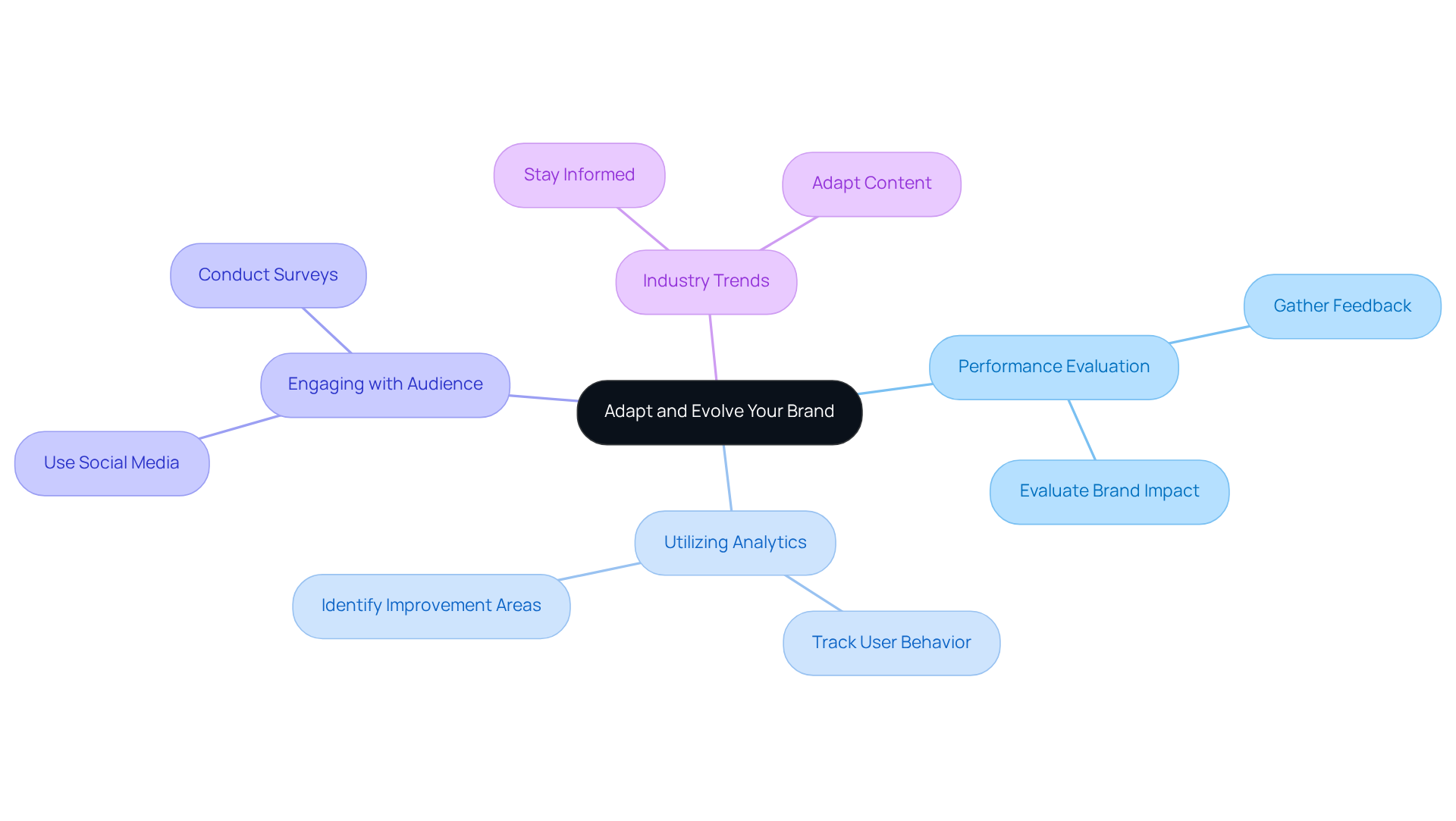Overview
In the world of tech startups, establishing a strong online presence can feel overwhelming. Many founders grapple with the challenge of creating a cohesive brand identity that resonates with their audience. This inconsistency can lead to confusion and a lack of trust among potential customers, which is a painful reality that can hinder growth and engagement.
Imagine pouring your heart into your startup, only to find that your website does not reflect the passion and vision you hold. This disconnect can be disheartening, making it crucial to address these branding issues head-on. The implications of neglecting your brand identity can be significant, impacting user experience and your ability to adapt to an ever-changing market.
But there is hope. By implementing best practices for effective website design branding, you can create a nurturing environment for your audience. Start by developing a comprehensive style guide that ensures consistency in visual elements and messaging. This guide will serve as a roadmap, helping you maintain a unified brand identity across all platforms.
Optimizing your website for mobile use and improving loading times are essential steps in enhancing user experience. Remember, your audience is looking for ease and accessibility. Additionally, don’t shy away from utilizing user feedback; it’s a valuable resource that can guide your brand’s evolution. By actively listening to your audience, you foster trust and engagement, creating a community that feels valued and understood.
We invite you to share your experiences and challenges in this journey. Together, we can navigate the intricacies of branding and design, ensuring that your startup not only stands out but also resonates deeply with your audience. Your story matters, and with the right strategies in place, you can build a brand that reflects your vision and connects with those who matter most.
Introduction
In today’s digital landscape, crafting a compelling online presence is not just important; it’s essential. Many tech startups find themselves facing a daunting challenge: establishing a unique brand identity that resonates with their audience, all while ensuring this identity remains consistent across various digital platforms. This can feel overwhelming, especially when first impressions are often formed within mere seconds.
Imagine pouring your heart and soul into your startup, only to realize that your online presence doesn’t reflect the passion behind your work. It’s a painful realization that many founders share. The implications of this disconnect can lead to lost opportunities and a lack of engagement from potential customers.
But there is hope. By employing effective practices for website design and branding, you can create a cohesive identity that not only enhances user experience but also drives engagement. This article will explore these practices, offering insights and solutions tailored for tech startups navigating the complexities of branding. Together, we can foster deeper connections with your audience while adapting to the ever-evolving digital marketplace. Let’s embark on this journey to ensure your brand not only stands out but also truly reflects the essence of your vision.
Establish a Cohesive Brand Identity
Creating a unified identity for your organization can feel overwhelming. Many tech startup founders grapple with defining their core values, mission, and vision. This challenge is particularly pronounced in innovative sectors like credit, where standing out is crucial. At RNO1, we understand the pressure to present a cohesive brand that resonates with your audience.
We emphasize a design-driven approach that permeates every aspect of website design branding and our digital solutions. By crafting a comprehensive style guide that includes your logo, color palette, typography, and imagery guidelines, you can establish a solid foundation. This guide serves as a reference for all website design branding components on your site, ensuring that every visual element aligns with your brand identity. For instance, if your company embodies innovation and tech-savviness, choosing modern fonts and a color scheme that reflects this ethos can make all the difference.
Consistency in these elements throughout your website design branding not only enhances recognition but also fosters a seamless experience for users. Think of companies like Apple, which maintain a consistent identity across all platforms, reinforcing their image as leaders in technology and design. By leveraging RNO1's Return On Design & Digital (RODD) strategies, you can maximize your product's marketability and operational resilience. Together, we can navigate this journey and create a brand that truly reflects your vision.

Implement Strategies for Brand Cohesion in Design
To create a cohesive identity, many tech startup founders face the challenge of inconsistency in their branding. This inconsistency can lead to confusion among potential customers, making it difficult for them to connect with the brand on a deeper level. It’s important to recognize how this can affect not just visibility, but also trust and engagement with your audience.
Now, let’s explore some nurturing strategies that can help you overcome this hurdle. First, consider the visual elements of your brand. Using consistent buttons, icons, and layouts can significantly align your identity and create a familiar experience for your users. Additionally, ensure that your messaging is uniform across all pages. Employing the same tone and language throughout your content reinforces your identity and builds trust.
Storytelling is another powerful tool you can use. By weaving your narrative throughout the website, you make it relatable and engaging. For example, a tech startup might share case studies or testimonials that illustrate how their product addresses real-world challenges, thereby strengthening their message and connecting with their audience on an emotional level.
By implementing these strategies, you can develop a cohesive design that resonates with individuals, enhancing their overall experience. Remember, it’s not just about aesthetics; it’s about creating a bond with your audience that fosters loyalty and trust.

Enhance User Experience to Drive Engagement and Conversions
To enhance the experience of your visitors, it's crucial to focus on a few key areas that can make a significant difference. Many individuals today access websites through their mobile devices, so ensuring your site is mobile-compatible is essential. Imagine the frustration of a potential customer trying to navigate a site that isn’t optimized for their phone; it’s a common issue that can lead to lost opportunities.
Furthermore, loading times play a pivotal role in visitor retention. Studies show that if a website takes more than three seconds to load, many visitors will simply leave. Think about how you feel when waiting for a page to load—it's disheartening, isn’t it? By prioritizing faster loading times, you not only keep your visitors engaged but also show them that you value their time.
Another aspect to consider is navigation. A clear and intuitive menu structure allows users to find information quickly, which is vital in today’s fast-paced environment. Have you ever felt lost on a website? It can be incredibly frustrating. Simplifying navigation can help alleviate this pain point, making it easier for your audience to connect with your content.
Incorporating interactive elements, such as chatbots or quizzes, can also significantly enhance engagement. For instance, eCommerce platforms that streamline the checkout process often see higher conversion rates, as customers appreciate a seamless experience. By fostering this kind of interaction, you create a welcoming atmosphere that encourages participation.
Ultimately, by prioritizing user experience, you can cultivate deeper connections with your audience and boost conversion rates. Remember, every small improvement contributes to a more nurturing environment for your visitors. Together, let's create a website design branding that not only meets but exceeds the expectations of visitors.

Adapt and Evolve Your Brand for Sustained Growth
To nurture and develop your identity, it's essential to routinely evaluate its performance and gather feedback from your consumers. Many founders face the challenge of understanding their brand's impact, which can be daunting. By utilizing analytics tools to track user behavior, you can pinpoint areas for improvement, ensuring your brand resonates with your audience. Staying informed about industry trends is crucial; being open to pivoting your branding strategies can make a significant difference.
For instance, RNO1's Ryde initiative showcases innovative strategies for scaling omnichannel ambassador programs. These approaches can greatly enhance e-commerce engagement through influencer partnerships. If a new technology arises that could enrich your product offering, consider how to weave it into your brand narrative. This adaptability is vital in today's fast-paced market.
Engaging with your audience through social media and surveys is another effective way to understand their evolving needs and preferences. Brands like Netflix exemplify this practice, continuously adapting their content offerings based on viewer preferences, which fosters sustained growth and relevance in a competitive landscape. By embracing these strategies, you can create a brand that not only meets but anticipates the needs of your audience, fostering a deeper connection and loyalty.

Conclusion
Establishing a strong brand identity through effective website design is a challenge many tech startups face, especially when trying to connect with their audience in a crowded market. It’s not just about standing out; it’s about creating a space that feels welcoming and trustworthy. By focusing on cohesive branding strategies, businesses can cultivate a unified visual and narrative presence that resonates deeply with users, fostering trust and engagement.
Key practices in this journey include:
- Developing a comprehensive style guide, which serves as a comforting roadmap, ensuring consistency in visual elements and messaging.
- Enhancing user experience through mobile optimization and intuitive navigation, as it reflects an understanding of users' needs.
- Incorporating storytelling and interactive features to further deepen connections with visitors, ultimately driving engagement and conversions.
- Adapting and evolving the brand based on analytics and consumer feedback, which is essential for sustained growth and relevance in a rapidly changing market.
In conclusion, the importance of branding in website design cannot be overstated. By embracing these best practices, startups can nurture a compelling online presence that not only captures attention but also builds lasting relationships with their audience. This journey is not just about business; it’s about creating a resilient brand that thrives in the digital landscape. It’s imperative for businesses to prioritize branding as a cornerstone of their online strategy, paving the way for a supportive community that uplifts and inspires.
Frequently Asked Questions
Why is establishing a cohesive brand identity important for tech startups?
A cohesive brand identity is crucial for tech startups to stand out in innovative sectors like credit, helping them define their core values, mission, and vision while resonating with their audience.
What approach does RNO1 recommend for creating a brand identity?
RNO1 emphasizes a design-driven approach that includes crafting a comprehensive style guide with elements such as your logo, color palette, typography, and imagery guidelines to ensure all visual elements align with your brand identity.
What components should be included in a style guide for brand identity?
A style guide should include your logo, color palette, typography, and imagery guidelines, serving as a reference for all website design branding components.
How does consistency in branding affect user experience?
Consistency in branding enhances recognition and fosters a seamless experience for users, making it easier for them to connect with the brand.
Can you provide an example of a company with a strong cohesive brand identity?
Apple is an example of a company that maintains a consistent identity across all platforms, reinforcing its image as a leader in technology and design.
What strategies does RNO1 offer to improve marketability and resilience?
RNO1 offers Return On Design & Digital (RODD) strategies to maximize a product's marketability and operational resilience, guiding companies in creating a brand that reflects their vision.




